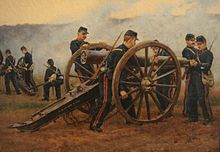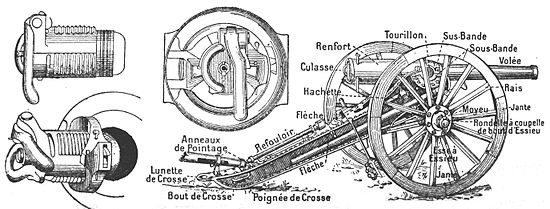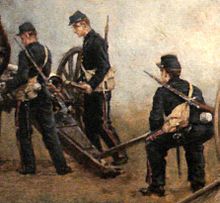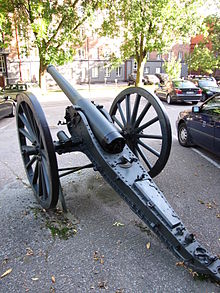- De Bange 90 mm cannon
-
 A 90mm de Bange artillery piece, in 1898. Painting by Etienne-Prosper Berne-Bellecourt (1838-1910). Musée de l'Armée.
A 90mm de Bange artillery piece, in 1898. Painting by Etienne-Prosper Berne-Bellecourt (1838-1910). Musée de l'Armée.
The De Bange 90 mm cannon (Mle 1877) was a type of field artillery piece developed in France by Colonel Charles Ragon de Bange in 1877, and adopted by the French Army that same year. It superseded the earlier Reffye cannon (1870) and the Lahitolle 95 mm cannon (1875).
Contents
Characteritics
The cannon was breech loading and used the original mushroom-shaped obturator system developed by de Bange, allowing to properly seal the breech during each firing.[1] The cannon still had an important recoil, meaning that it moved backward at each firing, necessitating re-aiming every time, which considerably slowed the rate of firing. This would remain a problem with all artillery pieces until the development of the recoilless Canon de 75 in 1897.
Replacement
The De Bange 90 mm was used during World War I, although it was obsolete by then, as there were important stockpiles of ammunition and French industry fell short of producing enough modern cannons for the war.[2] It was superseeded by the recoilless Canon de 75.
References
- ^ Field Artillery and Firepower by Jonathan B. A. Bailey, p.208
- ^ "The French responded to the ammunition crisis in early 1915 by reequipping one hundred batteries with the obsolete '90 de Bange' for which there were large reserve stocks of ammunition" in Field Artillery and Firepower by Jonathan B. A. Bailey, p.245
See also
 Media related to De Bange 90mm cannon at Wikimedia Commons
Media related to De Bange 90mm cannon at Wikimedia CommonsSmall arms Charleville musket · Delvigne rifle (1826) · Thouvenin Carabine à tige (1846) · Lefaucheux M1858 revolver · Minié rifle (1849) · Tabatière rifle (1864) · Chassepot rifle (1866) · Gras rifle (1874) · Lebel rifle (1886) · Modèle 1892 revolver





Machine guns Cannons Year XI system (1803) · Paixhans gun (1823) · Valée system (1828) · Canon obusier de 12 (1853) · La Hitte system (1858) · de Reffye system (1870) · Lahitolle 95 mm (1873) · de Bange system (1875) · Canet 320 mm (1880) · Canon de 75 (1897)
Warships Ammunition Lepage fulminate (1807-10) · Pauly-Prélat integrated cartridge (1808) · Prélat percusion cap (1818) · Lefaucheux cartridge (1836) · Tamisier ball (1841) · Minié ball (1847) · 8 mm Lebel smokeless powder cartridge (1886)
Systems Lepage percussion system (1807) · Marié-Davy naval periscope (1854) · De Bange breech obturator (1872) · Du Temple high-circulation steam engine (1876) · Krebs naval electric gyrocompass (1880) · Smokeless powder Poudre B (1886)
Operational
usageNapoleonic Wars · French conquest of Algeria · Crimean War · French weapons in the American Civil War · Franco-Prussian war

This artillery-related article is a stub. You can help Wikipedia by expanding it.



